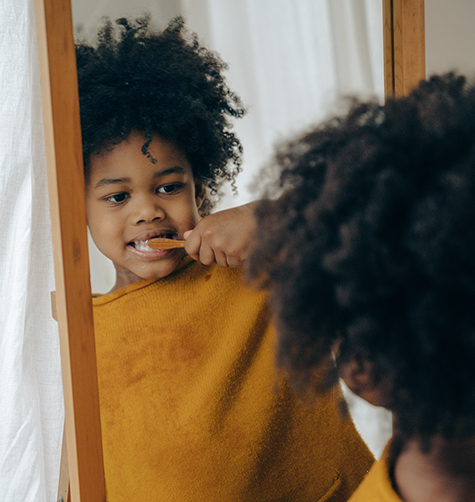Increasing Independence in Brushing Teeth

Teaching your child to brush their teeth is important to their dental and overall health. There are many skills a child needs to successfully complete this task including fine motor skills, motor planning, visual-motor skills, sequencing, and attention. Typically, children 4-5 years old are ready to practice brushing their teeth on their own. By 6 to 8 years old, children should be independent with brushing their teeth. Below are a few tips to help your child participate and learn this important life skill!
1. Allow child to hold the toothbrush while you gently guide their hand. Some children may feel more in control if they can hold the toothbrush. This will also help them to build more awareness as to how they should be moving their body to reach different areas of their mouth. If a toothbrush is not accepted, start by helping them use a damp washcloth to wipe their teeth clean.
2. Offer choices. Offering choices is another great way to increase your child’s sense of control over the situation. Your child may also need some time to figure out what their preferences are when it comes to brushing their teeth.
Experiment with different types of toothbrushes:
- Size
- Bristle firmness
- Handles – Using a toothbrush with a wider handle may be easier to hold for some children
- Colors
- Battery or electric (slight vibration)
- Singing toothbrush
Experiment with different types of toothpaste:
- Taste
- Brand
- Use less toothpaste or start without using any toothpaste
- Experiment with different water temperatures. Warm water may be better tolerated than cold water.
3. Small steps. Break down self-care skills into smaller steps and support your child through each step. Start small and let your child attempt to complete one or two steps of the sequence. Then slowly add more steps for them to complete. In time, they will be able to do more for themselves.
4. Use a visual. Use a visual support with pictures to represent each step (e.g., what area gets brushed first, second, third, etc.). This will help your child understand the steps and stay on task.
5. Use a mirror. Brush your child’s teeth in front of a mirror and talk about each section as you brush. This will help them gain an understanding of what areas of their mouth need to be brushed and ensure thorough brushing.
6. Use a timer. This will help your child understand time and cue them as to how long they should be brushing their teeth. You can try singing a familiar, preferred song, use a sand timer, or timer apps.
7. Build a routine. It is important that your child understands when they should be brushing their teeth throughout the day. Brushing teeth can be incorporated into their morning, lunchtime and bedtime routines.
8. Use a reward chart. Reward your child by placing a check or star on a reward chart for independent completion of tasks (or attempt at, in the early stages). This will help your child stay motivated to complete the task.
9. Make it a game! Make brushing teeth fun by pretending to zap away the germs. Incorporating play is a great way to make brushing teeth more enjoyable and increase your child’s interest.

Eyas Landing is a therapy clinic with a mission to provide evidence-based and family-centered therapy services for children, adolescents, and their families. The primary goal is to deliver relationship-based interventions within the most natural environments and to empower families to reach their full potential. To achieve this goal, our highly educated, compassionate staff dedicates time and expertise to create experiences that maximize therapeutic outcomes. The strength, determination, and perseverance of our clients are evident as they succeed in therapy, and ultimately in their daily lives.
Eyas Landing offers a wide range of comprehensive services including Speech Therapy, Occupational Therapy, Physical Therapy, ABA Therapy, Social Work, Family Therapy, and Neuropsych testing. Services are provided throughout the Chicagoland area via Telehealth, In-Home, and in our state of the art clinic.
Want to learn more or you have a specific question? Feel free to connect with us here!



